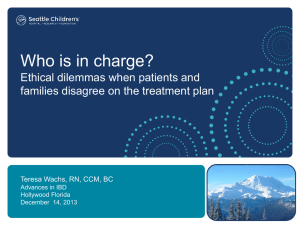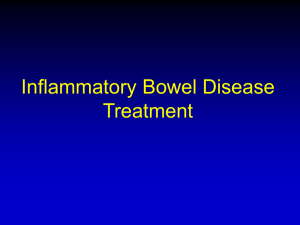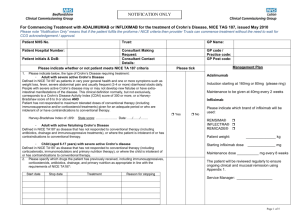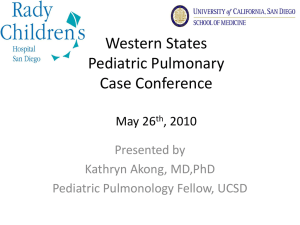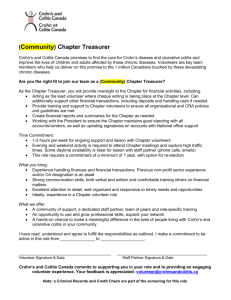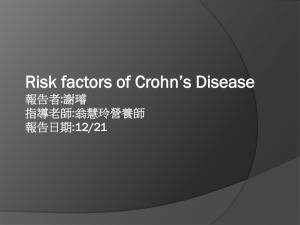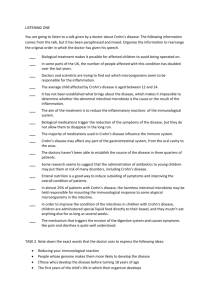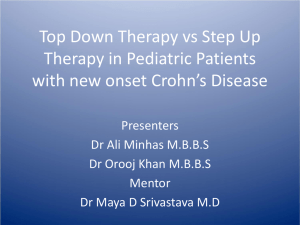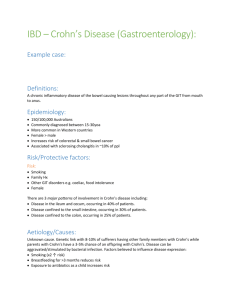Full Report (Word 363KB)
advertisement
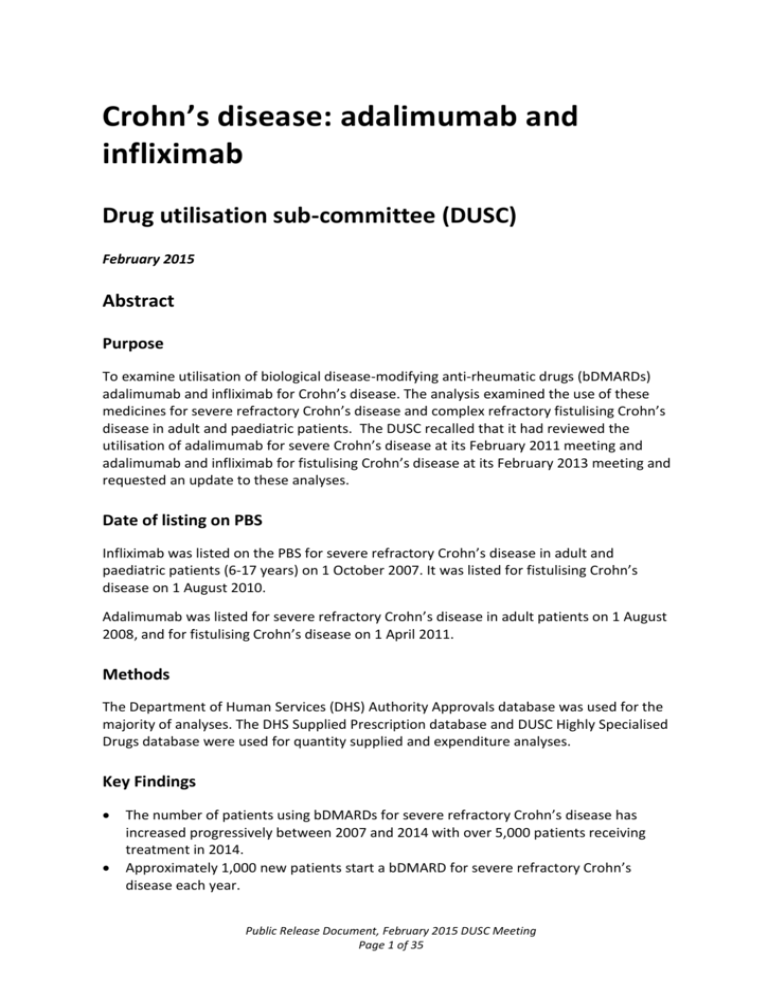
Crohn’s disease: adalimumab and infliximab Drug utilisation sub-committee (DUSC) February 2015 Abstract Purpose To examine utilisation of biological disease-modifying anti-rheumatic drugs (bDMARDs) adalimumab and infliximab for Crohn’s disease. The analysis examined the use of these medicines for severe refractory Crohn’s disease and complex refractory fistulising Crohn’s disease in adult and paediatric patients. The DUSC recalled that it had reviewed the utilisation of adalimumab for severe Crohn’s disease at its February 2011 meeting and adalimumab and infliximab for fistulising Crohn’s disease at its February 2013 meeting and requested an update to these analyses. Date of listing on PBS Infliximab was listed on the PBS for severe refractory Crohn’s disease in adult and paediatric patients (6-17 years) on 1 October 2007. It was listed for fistulising Crohn’s disease on 1 August 2010. Adalimumab was listed for severe refractory Crohn’s disease in adult patients on 1 August 2008, and for fistulising Crohn’s disease on 1 April 2011. Methods The Department of Human Services (DHS) Authority Approvals database was used for the majority of analyses. The DHS Supplied Prescription database and DUSC Highly Specialised Drugs database were used for quantity supplied and expenditure analyses. Key Findings The number of patients using bDMARDs for severe refractory Crohn’s disease has increased progressively between 2007 and 2014 with over 5,000 patients receiving treatment in 2014. Approximately 1,000 new patients start a bDMARD for severe refractory Crohn’s disease each year. Public Release Document, February 2015 DUSC Meeting Page 1 of 35 In 2014 1,345 patients received a bDMARD for fistulising Crohn’s disease and 394 patients received treatment for paediatric Crohn’s disease. A much higher proportion of patients continue with bDMARD treatment than originally expected with that 91.7 %, 93.9 % and 91.5 % of patients receiving a second authority approval for adalimumab or infliximab for severe Crohn’s disease, fistulising Crohn’s disease and paediatric Crohn’s disease respectively. In 2013, Government expenditure on bDMARDs for Crohn’s disease amounted to $103,840,325. Public Release Document, February 2015 DUSC Meeting Page 2 of 35 Purpose of analysis To assess the utilisation of adalimumab and infliximab for the treatment of Crohn’s disease. The analysis examined the use of these medicines for severe refractory Crohn’s disease and complex refractory fistulising Crohn’s disease in adult and paediatric patients. The DUSC recalled that it had reviewed the utilisation of adalimumab for severe Crohn’s disease at its February 2011 meeting and adalimumab and infliximab for fistulising Crohn’s disease at its February 2013 meeting and requested an update to these analyses. Background Pharmacology Infliximab and adalimumab are recombinant human immunoglobulin monoclonal antibodies that bind to tumour necrosis factor (TNF-) and inhibit its inflammatory action. 1,2 Therapeutic Goods Administration (TGA) approved indications Adalimumab is indicated for the treatment of moderate to severe Crohn’s disease in patients aged 6 years or older who had an inadequate response to conventional therapies or have lost response to or are intolerant of infliximab. Infliximab is indicated for the treatment of moderate to severe Crohn’s disease in adults and children and adolescents aged 6 to 17 years who have an inadequate response to conventional therapies. Both drugs are also indicated for the treatment of a number of other inflammatory conditions. 1 Remicade (infliximab)Australian Approved Product Information. Sydney: Janssen Cliag Pty Ltd. Approved 2 August 2000, Amended 11 February 2015. Available from <TGA website>. Accessed 15 Dec 2014. 2 Humira (adalimumab) Australian Approved Product Information. Sydney: AbbVie Pty Ltd. Approved 10 December 2003. Available from the <TGA website>. Accessed 15 Dec 2014. Public Release Document, February 2015 DUSC Meeting Page 3 of 35 Dosage and administration The dosage of adalimumab and infliximab in adult and paediatric patients are presented in Tables 1 and 2 respectively. Table 1: Dosage and administration of infliximab and adalimumab in adults Brand name and sponsor Product Dose and frequency of administration - initiating Dose and frequency of administration - continuing Remicade® Janssen-Cilag Pty Ltd Infliximab Weeks 0, 2, 6: 5 mg/kg Every 8 weeks: 5 mg/kg Humira® Adalimumab Day 0: 160 mg Day 28 and continuing AbbVie Pty Ltd Day 14: 80 mg fortnightly: 40 mg Source: Product information infliximab and Product information adalimumab Note: Infliximab is supplied as a 100 mg powder for IV infusions. Adalimumab is an injection, supplied as 40 mg in 0.8 mL in a pre-filled pen and pre-filled syringe Table 2: Dosage and administration of infliximab and adalimumab in paediatric patients Brand name and sponsor Product Dose and frequency of administration - initiating Dose and frequency of administration - continuing Remicade® Janssen-Cilag Pty Ltd Infliximab Weeks 0, 2, 6: 5 mg/kg Every 8 weeks: 5 mg/kg Humira® AbbVie Pty Ltd Adalimumab Less than 40kg Day 0: 80mg Day 28 and continuing fortnightly: Day 14: 40mg 10 mg (moderate disease) 20 mg (severe disease) Greater than or equal to 40kg Day 0: 160 mg Day 14: 80 mg Day 28 and continuing fortnightly: 20 mg (moderate disease) 40 mg (severe disease) Source: Product information infliximab and Product information adalimumab Note: Infliximab is supplied as a 100 mg powder for IV infusions. Adalimumab is an injection, supplied as 40 mg in 0.8 mL in a pre-filled pen and pre-filled syringe Adalimumab is given as a subcutaneous injection. Infliximab is given as an intravenous infusion over at least 2 hours. Adult patients may be given a faster infusion for subsequent infusions. Infliximab can be used in doses of 10mg/kg for adult and paediatric patients who have an incomplete response1, , however doses greater than 5mg/kg are not subsidised on the PBS. Adalimumab may also be used weekly during a disease flare or where patients have an inadequate response.2 Weekly dosing of adalimumab is not subsidised on the PBS. The current Product Information (PI) and Consumer Medicine Information (CMI) are available from the TGA (Product Information) and the TGA (Consumer Medicines Information). Public Release Document, February 2015 DUSC Meeting Page 4 of 35 Clinical situation3,4 Crohn’s disease is an inflammatory bowel disease. It causes inflammation of the full thickness of the affected parts of the digestive tract. It can affect any part of the digestive tract however; it more commonly affects the ileum or colon. People with Crohn’s disease may develop fistulae, abnormal passages connecting a part of the bowel to the skin, vagina, bladder or another part of the bowel. PBS listing details (as at November 2014) Table 3 presents the PBS listings of adalimumab and infliximab for Crohn’s disease. Infliximab is listed under the Highly Specialised Drugs (HSD) Program. Infliximab is given as an intravenous infusion therefore supply is restricted to public and private hospitals having access to appropriate specialist facilities. Medical practitioners prescribing infliximab are required to be affiliated with these specialist hospital units. 3 Digestive Health Foundation and Gastoenterology Society of Australia. Inflammatory Bowel Disease. 3rd Edition. 2013. Mulgrave: Digestive Health Foundation; 2013. Available from <http://www.gesa.org.au/files/editor_upload/File/Professional/33859_b-2.pdf>. Accessed 1 Dec 2014 4 Crohn’s and Colitis UK. Living with a fistula. St Albans, U.K: Crohn’s and Colitis UK; 2013. Available from <http://www.crohnsandcolitis.org.uk/Resources/CrohnsAndColitisUK/Documents/Publications/InfoSheets/Living%20with%20a%20Fistula.pdf>. Accessed 1 Dec 2014. Public Release Document, February 2015 DUSC Meeting Page 5 of 35 Table 3: PBS listings of adalimumab and infliximab for Crohn’s disease Initial or Change Form, strength & Drug, brand name and manufacturer Restrictions Adalimumab (Humira®) Fistulising Crohn’s disease Severe Crohn’s disease Short gut syndrome or Ostomy Extensive small intestine disease Infliximab (Remicade®) DPMQ Item Codes - $5,036.70 8961P - - $5,036.70 8962Q 2 2 5 $1,774.70 1 2 2 5 $1,774.70 40 mg syringe, 6 1 0 - - $5,036.70 9186L 40 mg cartridge, 6 1 0 - - $5,036.70 9187M 40 mg syringe, 2 1 2 2 5 $1,774.70 40 mg cartridge, 2 1 2 2 5 $1,774.70 100 mg injection, 1 1a 0 (max 2) 1a 0 (max 2) $751.70 (public) 9654D (public) $788.53 (private) 9617E (private) 100 mg injection, 1 1a 0 (max 2) 1a 0 (max 2) $751.70 (public) 5754W (public) $788.53 (private) 9613Y (private) 100 mg injection, 1 1a 0 (max 2) 1a 0 $751.70 (public) 5755X (public) (max 2) $788.53 (private) 9612X (private) qty Abbvie Pty Ltd Fistulising Crohn’s Disease Janssen-Cilag Pty Ltd Max Qty Rpts Max Qty Rpts 40 mg syringe, 6 1 0 - 40 mg cartridge, 6 1 0 40 mg syringe, 2 1 40 mg cartridge, 2 Severe Crohn’s disease Short gut syndrome or Ostomy Extensive small intestine disease Paediatric Crohn’s Disease Continuing or Grandfathered a Source: November 2014 PBAC Schedule The number of infliximab vials approved depends on patients’ weight Public Release Document, February 2015 DUSC Meeting Page 6 of 35 8963R (initial) 8964T (cont.) 8965W (initial) 8966X (cont.) 9188N (initial) 9189P (cont.) 9190Q (initial) 9191R (cont.) Restriction (abridged) Severe refractory Crohn’s disease defined as: Crohn’s Disease Activity Index (CDAI) assessment of 300 or more; OR Extensive small intestine disease (>50cm) with CDAI assessment 220, or Evidence of active intestinal inflammation based on blood, faecal or diagnostic imaging markers, or High faecal output state, or Assessed as requiring Total Parenteral Nutrition in the absence of TNF- antagonist treatment; OR Short gut syndrome or has had a ileostomy or colostomy with Evidence of active intestinal inflammation based on blood, faecal or diagnostic imaging markers, or High faecal output state, or Assessed as requiring Total Parenteral Nutrition in the absence of TNF- antagonist treatment Patients must have failed to have an adequate response with a tapered course of corticosteroids and either azathioprine, 6-mercaptopurine or methotrexate. Patients may receive an initial authority approval for up to 16 weeks of adalimumab treatment or 14 weeks of infliximab treatment. Patients need to be assessed for response after 12 weeks of adalimumab treatment or up to 12 weeks after the first infliximab dose. To qualify for continuing treatment, patients need to achieve a CDAI score less than 150 or normalisation of blood, faecal or diagnostic imaging markers of intestinal inflammation. Patients switching between treatments receive the same initial treatment duration and assessment to response as new patients. Refractory paediatric Crohn’s disease (6-17 years) – Infliximab only Paediatric Crohn’s Disease Activity Index (PCDAI) Score greater than or equal to 30 Failed to have an adequate response to two of the three following therapies: a tapered course of steroids over 6 weeks (1 mg/kg or 40mg prednisolone or equivalent), 8 week course of enteral nutrition, Immunosuppressive therapy including azathioprine or 6-mercaptopurine or methotrexate for 3 or more months. Patients must be assessed for response by PCDAI up to 12 weeks after the first dose. Patients need to achieve a PCDAI response 15 points lower than baseline and less than 30 to be eligible for continuing treatment. Public Release Document, February 2015 DUSC Meeting Page 7 of 35 Fistulising Crohn’s disease Patient must have externally draining enterocutaneous or rectovaginal fistula. Patients need to demonstrate response following at least 12 weeks of treatment. Response is defined as: 50% or greater decrease in the number of open draining fistulae, OR a marked reduction in drainage of all fistula(e) from baseline, together with less pain and induration as reported by the patient. Patients may receive continuing authority approvals for 24 weeks treatment at a time providing they continue to sustain the response. Patients are able to switch between adalimumab and infliximab. This class of medicines has complex restrictions. For full wording of the restrictions, including notes, refer to the current schedule on PBS.gov.au Date of listing on PBS Infliximab was listed on the PBS for severe refractory Crohn’s disease in adult and paediatric patients (6-17 years) on 1 October 2007. Adalimumab was listed for severe refractory Crohn’s disease in adult patients on 1 August 2008. Infliximab for fistulising Crohn’s disease was listed on 1 August 2010. Adalimumab was listed for fistulising Crohn’s disease on 1 April 2011. On 1 January 2011, the corticosteroid dosing requirement for the infliximab paediatric Crohn’s disease listing was changed from a dose of 40mg daily to 1 mg per kg or 40mg (whichever is lesser). This change was made following a request from the Paediatric Medicines Advisory Group. Current PBS listing details are available from the PBS website. Relevant aspects of the PBAC consideration Infliximab for severe Crohn’s Disease – March 2007 The PBAC recommended the listing of infliximab for the treatment of patients with severe Crohn’s disease (Crohn’s Disease Activity Index ≥ 300) or patients with an ileostomy or colectomy due to Crohn’s disease on the basis of high and acceptable cost-effectiveness compared to placebo. Continuation of treatment beyond three doses was determined by remission (CDAI ≤ 150) at approximately 12 weeks from the commencement of treatment. The recommended listing was more restrictive than that original proposed by the sponsor, which requested treatment for patients with a CDAI > 220 and allowed continuation for patients who achieved an improvement in CDAI > 70 from baseline. Public Release Document, February 2015 DUSC Meeting Page 8 of 35 A copy of the Public Summary Document from the March 2007 PBAC meeting is available on the PBAC Meetings website. Prior to the March 2007 recommendation, infliximab was considered by the PBAC for Crohn’s disease at three PBAC meetings: June 2000, December 2000, and September 2001. On each occasion, the PBAC rejected the request for subsidy. ''''''''''' '''''''''''''''''''''''' ''''''''''' '''''' '''''''''' '''''''''' ''''''' ''''' ''''''''''''''''' ''''''' '''''''''' '''''''' '''''''''''''''''' '''''''''''' '''''' ''''''' ''''' '''''''''''''''''''''' '''''''''''' The PBAC rejected these submissions on the basis of the uncertainty regarding subsequent doses and unacceptable cost-effectiveness. Stakeholder meeting A stakeholder meeting was held in May 2007 in relation to the use of infliximab in Crohn’s disease. '''''''' ''''''''''''''''' '''''' ''''''''''''''' ''''''' ''''' ''''''''''''''' '''''''' '''''' ''''''''''' '''''''''''' ''''' '''''' '''''''''''' '''''''''' ''''''''''''''''''''''''''''''' In addition, as part of the recommendation the Committee had agreed to meet with clinicians to discuss the wording of a restriction that would allow a group of patients suffering from severe disease but for whom a CDAI (Crohn’s Disease Activity Index) was inappropriate e.g. those with ileostomies, ostomies and short bowel syndrome to access treatment. Some of the key clinical suggestions included: The CDAI score is very sensitive to the contribution of diarrhoea to the score. Patients who have a colostomy, ileostomy or small bowel syndrome cannot generate a high CDAI score although they may have severe disease based on a global assessment of their condition. In patients whom the CDAI score is inappropriate for measuring disease severity, other markers such C-reactive protein, erythrocyte sedimentation rate, platelet count, lactoferrin or endoscopy may be appropriate. A CDAI of ≤ 200 at week 12 would be an appropriate criteria for continuation therapy in patients whom CDAI scores are meaningful. May 2007 Special Meeting – Infliximab severe Crohn’s disease The sponsor made a submission requesting different continuation criteria than recommended by the PBAC at its March 2007 meeting. The submission requested patients be required to achieve a 100-point reduction from baseline in their CDAI score, rather than achieving remission (CDAI ≤ 150). The PBAC considered the cost-effectiveness estimates presented in the re-submission served to heighten rather than allay these concerns'' '''' ''''''' ''''''''''''''''''''' '''''''' ''''''''''''''''''''''''' ''''''''' '''''''''''' ''''''''''''''' '''''''''' ''''''' '''''''''''''' ''''''''''''''''''''''''' '''''''''''''''''''''''' ''''''''''''''''' ''''' '''''' '''''''''''''''' ''''''' ''''''''''' '''''''''''''''''' ''''''''''''''''''' '''' '''''' '''''''''' ''''''''''''''''' ''''''''''' '''''' ''''''''''' ''''''''''' ''''''''''''''''''''''''' ''''''''''''''''''''''''''''' ''''' '''''''''''' The PBAC therefore deferred the submission and requested that the sponsor provide a new submission which addresses the concerns about the economic model and which provides cost-effectiveness estimates using the initiation and continuation criteria recommended by the participants at the stakeholder meeting. The PBAC reaffirmed its recommendation Public Release Document, February 2015 DUSC Meeting Page 9 of 35 made in March to list infliximab for the treatment of severe Crohn’s disease with an initial CDAI of ≥ 300 and continuing treatment CDAI ≤150. The sponsor subsequently chose to proceed with the listing recommended at the March 2007 meeting. Infliximab for paediatric Crohn’s Disease –July 2007 The PBAC recommended the listing of infliximab for the treatment of Crohn’s disease in patients aged 6-17 years inclusive who are refractory to conventional therapies, on the basis of acceptable cost-effectiveness compared to placebo. A copy of the Public Summary Document from the July 2007 PBAC meeting is available on the PBAC Meetings website. Adalimumab for Crohn’s Disease –November 2007 The PBAC recommended the listing of adalimumab on the PBS for the treatment of patients with moderate to severe Crohn’s disease (CDAI > 300) or in patients with an ileostomy or colectomy due to Crohn’s disease on a cost-minimisation basis compared with infliximab. The PBAC agreed that the Crohn’s disease listing for adalimumab should be identical to infliximab, although there should be no specific listing for the paediatric population as adalimumab has not been trialled in children, and that the interchangeability rules should be the same as the rules which apply to the bDMARDs for other PBS-listed conditions. The PBAC considered that patients should continue on adalimumab only if they were in remission (i.e. CDAI ≤ 150) and not as proposed in the alternative listing in the submission of a decrease of ≥ 150 points, as the ICER for this continuation rule was unacceptably high. A copy of the Public Summary Document from the November 2007 PBAC meeting is available on the PBAC Meetings website. Infliximab for fistulising Crohn’s Disease –March 2010 The PBAC recommended listing of infliximab for complex refractory fistulising Crohn’s disease with a draining enterocutaneous or rectovaginal fistula, on the basis of a high, but acceptable, cost effectiveness ratio, in the context of a serious medical condition that has a large impact on the quality of life of often otherwise healthy younger patients. A copy of the Public Summary Document from the March 2010 PBAC meeting is available on the PBAC Meetings website. Adalimumab for fistulising Crohn’s Disease –November 2010 The PBAC recommended the listing of adalimumab on the PBS for the treatment of complex, refractory fistulising Crohn’s disease with a draining enterocutaneous or rectovaginal fistula on a cost-minimisation basis with infliximab, at the same price as the current listing for adalimumab for severe refractory Crohn’s disease. The PBAC considered a restriction consistent with the current listing for infliximab for fistulising disease, using the same adalimumab doses used in the listing for severe refractory Crohn’s disease was Public Release Document, February 2015 DUSC Meeting Page 10 of 35 appropriate. The PBAC recommended that patients be permitted to cycle between PBSsubsidised infliximab and adalimumab using similar criteria to those for the severe refractory Crohn’s disease listings. The PBAC noted that a proportion of patients with fistulising disease and a CDAI score ≥ 300 are already able to access PBS-subsidised adalimumab under the current Crohn’s disease listing. However, there may be patients with worse fistulae but with a lower CDAI who are not currently eligible and that this represents an equity issue. The PBAC noted that the presence of fistulae adds only around 20 points to the overall CDAI score. The PBAC also noted that there was a high clinical need for an alternative treatment that can be given by an alternative route other than intravenously and that morbidity of the disease is high. The PBAC noted that the results of the indirect comparison suggested that patients treated with adalimumab are more likely to have complete fistula closure compared with patients treated with infliximab (RR=1.54, [95% CI 0.54, 4.21]). The difference was not statistically significant; however, the trials were not specifically powered to detect differences in this outcome. Adalimumab for paediatric Crohn’s Disease –November 2014 At the November 2014 meeting, the PBAC recommended the listing of adalimumab for the treatment of severe refractory Crohn’s disease in paediatric patients aged 6 to 17 years. Approach taken to estimate utilisation Infliximab for Severe Crohn’s Disease – March 2007 An epidemiological approach was used to estimate utilisation. The key assumptions were: ''''' ''' ''''''''' ''''''' '''''' '' '''''' ''''''''' '''''''' ''''' ''''''''''''''''' '''' '''''''''''' ''''''''''''''''''''' Public Release Document, February 2015 DUSC Meeting Page 11 of 35 The key assumptions for paediatric patients were: A summary of the estimates are presented in Table 4, 5 and 6. Table 4: Infliximab estimates for CDAI 300 severe refractory Crohn’s disease population Year 1 Year 2 Year 3 Year 4 Year 5 Year 6 Patients ''''''' ''''''' '''''''' ''''''' ''''''' ''''''' Doses ''''''''' '''''''''' ''''''''''' '''''''''' ''''''' '''''''' Vials '''''''''''''' ''''''''''''' '''''''''''' ''''''''''' '''''''''''' ''''''''''' '''''''''''''''''''' '''''''''''''''''''''' '''''''''''''''''''''' '''''''''''''''''''' '''''''''''''''''''' '''''''''''''''''''''' Net cost to R/PBS Source: Infliximab Severe Crohn’s disease final estimates, July 2007. Note: Patient co-payments were not removed for infliximab costs Table 5: Infliximab estimates for CDAI exempt (ostomy and short gut patients) severe refractory Crohn’s disease population Year 1 Year 2 Year 3 Year 4 Year 5 Year 6 Patients '''''''''''' '''''''''' ''''''' ''''''' '''''''' '''''''' Doses '''''''''' '''''''''' '''''''''''' '''''''''' '''''''''''' ''''''' Vials '''''''''''''' '''''''''''''' '''''''''''' '''''''''''' '''''''''' '''''''''' ''''''''''''''''''''''' ''''''''''''''''''''' ''''''''''''''''''''' ''''''''''''''''''' ''''''''''''''''''' ''''''''''''''''''''' Net cost to R/PBS Source: Infliximab Severe Crohn’s disease final estimates, July 2007. Note: Patient co-payments were not removed for infliximab costs Public Release Document, February 2015 DUSC Meeting Page 12 of 35 Table 6: Infliximab estimates for paediatric patients with refractory Crohn’s disease Year 1 Year 2 Year 3 Year 4 Year 5 Year 6 Patients '''''' ''''' ''''''' '''''''' '''''''' '''''''' Doses '''''''' ''''''' ''''''' '''''''''' ''''''''' ''''''''' Vials '''''''''' '''''''''''' ''''''''''' '''''''''' '''''''''''' '''''''''' ''''''''''''''''''''' '''''''''''''''''''' ''''''''''''''''''''' '''''''''''''''''''' Net cost to R/PBS ''''''''''''''''''' ''''''''''''''''''' Source: Infliximab Severe Crohn’s disease final estimates, July 2007. Note: Patient co-payments were not removed for infliximab costs Adalimumab – Severe Crohn’s disease The financial estimates for adalimumab used a mixed epidemiological and market share approach. The key assumptions are as follows: Public Release Document, February 2015 DUSC Meeting Page 13 of 35 ''''''''''' ''''''' '''''''''''''''' '''''''''''' ''''''''''''''' '''' ''''''''''''''' '''' '''''' '''''''' ''''''''''''''''' ''''''' '''''''''''''' '''' ''''''''''''''''' ''''''''''''''''''''' ''''' ''''' '''''''''''''' '''''''''''''''''' '''''' '''''''''''''' '''''''''''''''''''' '''''''' ''''''''' ''' '''''''''''''''' ''''' ''' ''''''''''' ''''''' '''''''''''''' '''''''''''''' ''''''''''''''''''' '''''' '''''''''''''''''''''''' '''''' '''''''''' '''''''''''' '''''''''' '''''' ''''''''''''''''''' A summary of the adalimumab estimates are presented in Table 7. Table 7: Adalimumab estimates for severe refractory Crohn’s disease Year1 (2008) Year 2 Year 3 Year 4 Year 5 Year 6 (2009) (2010) (2011) (2012) (2013) Patients '''''''''' ''''''''''' '''''''''''' ''''''''''' '''''''''''' ''''''''''' Prescriptionsa ''''''''''' ''''''''''''' '''''''''''''' ''''''''''''' '''''''''''''' '''''''''''' ''''''''''''''''''''''''' ''''''''''''''''''''''''' ''''''''''''''''''''''' ''''''''''''''''''''' ''''''''''''''''''''''' ''''''''''''''''''''''' Net cost to R/PBS Source: Adalimumab Severe Crohn’s disease final estimates, June 2008. a Calculated by the DUSC secretariat based on cost per course assumptions in the estimates. Infliximab for Fistulising Crohn’s Disease – March 2010 An epidemiological approach was used to estimate utilisation. The key assumptions were: Public Release Document, February 2015 DUSC Meeting Page 14 of 35 A summary of the estimates are presented in Table 8. Table 8: Infliximab estimates for fistulising Crohn’s disease Year1 Year 2 Year 3 Year 4 Year 5 (2010) (2011) (2012) (2013) (2014) ''''''' '''''''' ''''''' '''''''' ''''''' Doses '''''''''''' ''''''''''' ''''''''''' '''''''''' '''''''''''' Vials '''''''''' ''''''''''' '''''''''' '''''''''''''' ''''''''''''' Net cost to R/PBS ''''''''''''''''''' Patients '''''''''''''''''''''' ''''''''''''''''''''''' '''''''''''''''''''''' ''''''''''''''''''' Source: Infliximab fistulising Crohn’s disease estimates, March 2010 submission to PBAC The PBAC noted that the submission’s predictions of utilisation were a likely underestimate. Adalimumab for Fistulising Crohn’s Disease – November 2010 An epidemiological approach was used to estimate utilisation. The key assumptions were: A summary of the estimates are presented in Table 9. Public Release Document, February 2015 DUSC Meeting Page 15 of 35 Table 9: Adalimumab estimates for fistulising Crohn’s disease Patients Packs Net cost to R/PBS Year1 Year 2 Year 3 Year 4 Year 5 ''''''' '''''''' '''''''' ''''''' '''''''' ''''''''''' '''''''''''' ''''''''''' ''''''''''' '''''''''''' '''''''''''''''''''''''' ''''''''''''''''''''' ''''''''''''''''''''''''' ''''''''''''''''''''' '''''''''''''''''''''''' Source: Adalimumab fistulising Crohn’s disease submission, November 2010 Previous reviews by DUSC Adalimumab for severe Crohn’s disease – February 2011 The analysis found the number of patients treated with adalimumab as well as expenditure to be lower than predicted. The rates of continuation for adalimumab and infliximab were higher than predicted. Adalimumab had gained a larger market share than originally predicted. Fistulising Crohn’s disease – February 2013 The DUSC considered that the utilisation of adalimumab and infliximab for fistulising Crohn’s disease was within the range expected for the first year of listing. The DUSC noted that any future analyses of the utilisation of tumour necrosis factor alpha inhibitors for Crohn’s disease would be enhanced by assessing rates of continuation and discontinuation. Methods The Authority Approvals database was used to examine the number of patients, patient age and the proportion of patients continuing treatment after their initial course of therapy. Patients were counted as receiving treatment in a particular year if they received an Authority approval that year. It is assumed patients will receive at least one approval a year because no more than 24 weeks of treatment is approved for Crohn’s disease at one time. This may be a small overestimate because some patients will receive an Authority approval but not have the medicine dispensed. The DHS Medicare Supplied Prescriptions Database was used for expenditure and prescriptions supplied data for adalimumab. The Highly Specialised Drugs Database was used for expenditure and quantity supplied data for infliximab. As this analysis uses date of supply data, there may be small differences compared with publicly available DHS Medicare date of processing data. Same day authority approvals were counted as a single approval for the analysis of continuation. This occurred predominantly when patients started a course of adalimumab and would receive an approval for a single 6 x 40mg pack and also for 2 x 40mg pack with repeats for the subsequent doses for the initial treatment period. Public Release Document, February 2015 DUSC Meeting Page 16 of 35 For predicted versus actual analyses, the percentage difference is calculated as (actualpredicted)/predicted. Results Analysis of drug utilisation Patient numbers Figures 1 and 2 present the total and new patient numbers for severe refractory Crohn’s disease and fistulising Crohn’s disease. Severe refractory Crohn's disease - total patients Severe refractory Crohn's disease - new patients 6,000 Patients 5,000 4,000 3,000 2,000 1,000 0 2007 2008 2009 2010 2011 2012 2013 2014 Year Figure 1: Severe refractory Crohn’s disease patients Source: DHS Authority approvals database, accessed November 2014. 2014 figures complete to October 2014 Public Release Document, February 2015 DUSC Meeting Page 17 of 35 Fistulising crohn's disease - total patients Fistulising crohn's disease - new patients 1,600 1,400 Patients 1,200 1,000 800 600 400 200 0 2010 2011 2012 2013 2014 Year Figure 2: Fistulising Crohn’s disease patients Source: DHS Authority approvals database, accessed November 2014. 2014 figures complete to October 2014 The DUSC noted that the pattern of utilisation for fistulising Crohn’s disease was similar to that for severe refractory Crohn’s disease with a relatively consistent number of new patients each year. A small number of patients (fewer than 30 each year) received Authority approvals for both severe refractory and fistulising Crohn’s disease indications. Figure 3 presents the number of patients using infliximab for paediatric Crohn’s disease. Paediatric Crohn's disease - total patients 400 Change in steroid dosing requirement Jan 2011 350 300 Patients Paediatric Crohn's disease - new patients 250 200 150 100 50 0 2007 2008 2009 2010 2011 2012 2013 2014 Year Figure 3: Paediatric Crohn’s disease patients Source: DHS Authority approvals database, accessed November 2014. 2014 figures complete to October 2014 Public Release Document, February 2015 DUSC Meeting Page 18 of 35 The DUSC noted that the number of new paediatric patients per year was fairly stable between 2008 and 2011, however has increased since the change to the restrictions effective 1 January 2011 of the corticosteroid dosing requirements to mg/kg dosing. Continuation The proportion of patients who received a second authority approval for adalimumab and infliximab between 2011 and 2013 for the treatment of severe Crohn’s disease was 91.7%. The number who recived a second authority approval for the treatment of fistulising Crohn’s disease was 93.9% and for paediatric Crohn’s disease was 91.5%. The majority of patients who start adalimumab or infliximab for Crohn’s disease receive a subsequent authority approval. A first authority approval for infliximab and adalimumab lasts for 14 weeks and 16 weeks respectively. The continuation rates for the individual years do not vary substantially from the aggregate result. Figures 4 to 6 present the longer term rates of continuation for patients who started treatment for severe, fistulising or paediatric Crohn’s disease, respectively, in 2011. Both figures 4 and 5 present the rate of continuation with each drug separately as well as patients who switch between adalimumab and infliximab and continue treatment (i.e. total time on either treatment). Patients received their seventh authority approval at an average of 132 weeks and 133 weeks for adalimumab and infliximab respectively. Figure 4: Continuation of biologic treatment for severe Crohn’s disease – 2011 patients Source: DHS Authority approvals database, accessed November 2014. 2014 figures complete to October 2014 Public Release Document, February 2015 DUSC Meeting Page 19 of 35 Figure 5: Continuation of biologic treatment for fistulising Crohn’s disease – 2011 patients Source: DHS Authority approvals database, accessed November 2014. 2014 figures complete to October 2014 Continuation with adalimumab is generally higher than continuation with infliximab for both severe and fistulising Crohn’s disease indications. Overall, the continuation rates are substantially higher than the predicted rates of 30-40% in the submissions. Figure 6 presents the long term continuation rates of infliximab for paediatric Crohn’s disease. Infliximab (paediatric) 100% % of patients 80% 60% 40% 20% 0% 1 2 3 4 5 6 7 Authority approval number Figure 6: Continuation of biologic treatment for paediatric Crohn’s disease – 2011 patients (infliximab only) Source: DHS Authority approvals database, accessed November 2014. 2014 figures complete to October 2014 (n=67) The longer term continuation rates of infliximab for paediatric Crohn’s are slightly higher than in the other indications. The DUSC further noted that across the three indication groups, over 70 % of patients remain on bDMARD treatment two years after initiation (sixth authority approval) and over 50 % are continuing on their original medicine. Public Release Document, February 2015 DUSC Meeting Page 20 of 35 Table 10 presents a comparison of the rates of continuation for adalimumab and infliximab for severe Crohn’s disease in practice compared with the clinical trials. Public Release Document, February 2015 DUSC Meeting Page 21 of 35 Table 10: Comparison of continuation rates for severe Crohn’s disease CDAI < 150 in trial (time of assessment) Response rate (time of assessment) ''''''''''' ''''''''''' '''''' '''''''''''' '''''''''''' '''''' ''''''''''' ''''''''''' ''''''' ''''''''''' '''''''''''' '''''' (ACCENT I) '''''''''''' ''''''''''' ''''''' ''''''''' '''''''''''' '''''' ''''''''' '''''''''''' '''''' (CHARM) ''''''' '''''''''''''''''''''' ''''''' ''''''''''''''''''''''' (CLASSIC II) ''''''''''''''' ''''' '''''''''''' ''''''' ''''' '''' '''''''' '''''''''''' ''''''''''''''''' ''''''''' ''''' ''''''' '''' '''''''''''''''''' '''''''''''''' '''''''''''''' ''''''''''' ''''''''''''' '''''''''''''' ''''''''''''' '''''''''''''' ''''''''''''' '''''''''''' Adalimumabb Severe Crohn’s disease Adalimumabc Severe Crohn’s disease Continuation (economic model) '''''''''''''''''' Infliximab a Severe Crohn’s disease Loss of response (outcome) ''''''''' '''''''''''' '''''' ''''''''' ''''''''''' ''''''' '''''''' '''''''''''' '''''' ''''''''' ''''''''''' ''''''' ''''''''' ''''''''''' '''''' '''''''' '''''''''' '''''''''''''''' ''''''''' '''' ''''''' ''''' '''''''''''''''''''' ''''''''''''''''''' '''''''''''''''''''''' '''''''' '''' ''''' ''''''''''' '''''''''' '''''''''''' ''''''''''' '''''' '''''''''''''' ''''''''''' '''''' ''''''''''''''' '''''''''''' ''''''' '''''''''''''' '''''''''''' '''''' '''''''''''' Continuation (financial estimates) Actual continuation (PBS data, 2011 initiators) '''''''' '''''''''''' '''''' ''''''''''' '''''''''''' '''''' '''''''' ''''' '''''''''''' ''''' ''''''''''''''' '''''''''''''''''' ''''''''''''''''' ''''' ''''''''''' ''''' Approval 2 (1022wks): 80% Approval 4 (58-75 wks): 62% ''''''''' '''''''''''''' ''''''''''''''''''''''''''''' Approval 6 (106-125 wks): 53% ''''''''' '''''''''''''''''' ''''''''''' '''''' Approval 2 (1022wks): 87% ''''''''''' '''''''''''' ''''''' '''''''' '''' ''''''''''''''''' ''''''''' ''''''''''''''''' '''' ''''''''''' ''''' '''''' ''' ''''''''''''''''''' '''' ''''''''''' ''''''' Approval 4 (58-75 wks): 72% Approval 6 (106-125 wks): 61% '''''''' ''''''''''''''''''''' ''''''''''' ''''''' Approval 2 (1022wks): 87% '''''''''''' ''''''''''' ''''''' ''''''''' '''' '''''''''''''' '''''''''' ''''''''''''''''' '''' '''''''''' ''''' '''''' '''' '''''''''''''''''''' '''' ''''''''''' ''''''' Approval 4 (58-75 wks): 72% Source: Infliximab March 2007 commentary, Adalimumab November 2007 Commentary. IQR = inter quartile range Note: Continuation in this table refers to continuation with the same medicine a ACCENT I trial: Response = CDAI reduction 70 points and 25% from baseline b CHARM trial: m-ITT population only includes patients who responded to adalimumab at week 4. Response = CDAI reduction 70 points c CLASSIC I and II trials: Response = CDAI reduction 70 points Public Release Document, February 2015 DUSC Meeting Page 22 of 35 Approval 6 (106-125 wks): 61% The DUSC noted that the rates of continuation in the PBS population are substantially higher than rates of remission and response in the key trials as well as the continuation rate in the economic models and financial estimates. Infliximab dose in adult patients A longitudinal analysis of infliximab dose for both severe and fistulising Crohn’s disease was undertaken for patients who received their first authority approval for infliximab in 2011 and had at least one approval for infliximab in the subsequent years including 2014. The average number of vials approved for infliximab increased between 2011 and 2014 from 3.88 to 4.22. A distribution of the number of vials dispensed is presented in Figure 7. 2011 2012 2013 2014 50% % of approvals 40% 30% 20% 10% 0% 2 3 4 5 6 7 Vials per approval Figure 7: Infliximab vial distribution for patients starting treatment in 2011 (n=399) Source: DHS Authority approval database, extracted November 2014. Approvals for 1, 8 and 9 vials have been omitted from the graph due to small patient numbers. There has been a gradual increase in the number of vials per approval for this cohort of patients that is reflected both in the average number of vials approved and the results in Figure 7. Public Release Document, February 2015 DUSC Meeting Page 23 of 35 Age and infliximab dose in paediatric patients Figure 8 presents the age of patients who received infliximab for paediatric Crohn’s disease in the 2013-14 financial year. Patients (n=388) % of patients 20% 15% 10% 5% 0% <10 10 11 12 13 14 15 16 17 18 Patient age Figure 8: Age of paediatric patients receiving treatment in 2013-14 financial year Source: DHS Supplied prescriptions database, extracted December 2014. Note: Age was calculated at the date of supply of first prescription in the period. The majority of paediatric patients are aged 13 to 17 years. Approximately 12% of patients who received infliximab under the paediatric Crohn’s disease item codes were aged 19 years or older. Figure 9 presents the distribution of vials per prescription supplied to paediatric patients in the 2013-14 financial year. Vials % of prescriptions 50% 40% 30% 20% 10% 0% 1 2 3 4 5 6 7 Vials per prescription Figure 9: Infliximab vial distribution for paediatric patients in 2013-14 financial year (n=1,970 prescriptions) Source: DHS Supplied prescriptions database, extracted December 2014. The average of 3.27 vials per prescription was supplied to paediatric patients in the 2013-14 financial year. This is higher than predicted. Public Release Document, February 2015 DUSC Meeting Page 24 of 35 Analysis of expenditure Table 11 presents the PBS expenditure on adalimumab and infliximab for Crohn’s disease. Table 11: PBS expenditure on infliximab on Crohn’s disease 2007 2008 2009 2010 2011 2012 2013 2014 (first half) Fistulising Not yet listed Not yet listed Not yet listed $1,225,010 $5,624,015 $7,664,945 $10,490,349 $6,172,992 Paediatric $95,608 $655,264 $1,278,383 $2,277,511 $2,521,470 $3,080,502 $4,230,808 $2,587,912 Severe $1,205,370 $9,987,591 $13,855,304 $18,093,409 $22,461,247 $26,792,579 $32,433,898 $18,896,873 Total Crohn's disease $1,300,978 $10,642,855 $15,133,687 $21,595,930 $30,606,732 $37,538,026 $47,155,055 $27,657,777 Source: DHS Supplied Prescriptions Database, extracted December 2014 (adalimumab), DUSC HSD Database, extracted December 2014 (infliximab) Table 11: PBS expenditure on adalimumab on Crohn’s disease 2007 2008 2009 2010 2011 2012 2013 2014 (first half) Fistulising Not yet listed Not yet listed Not yet listed Not yet listed $1,920,108 $6,392,210 $8,894,332 $7,205,933 Severe Not yet listed $4,186,920 $19,822,719 $27,272,281 $34,234,197 $40,998,386 $47,790,939 $36,259,710 Total Not yet listed $4,186,920 $19,822,719 $27,272,281 $36,154,305 $47,390,596 $56,685,270 $43,465,644 $1,300,978 $14,829,775 $34,956,406 $48,868,211 $66,761,037 $84,928,622 $103,840,325 $71,123,421 Total Crohn's disease Source: DHS Supplied Prescriptions Database, extracted December 2014 (adalimumab), DUSC HSD Database, extracted December 2014 (infliximab) Note: Special pricing arrangements apply. As DUSC analyses are usually based on date of supply there may be small differences between publicly available Medicare Australia date of processing data. The expenditure data is based on the prices published in the PBS Schedule. Public Release Document, February 2015 DUSC Meeting Page 25 of 35 Figure 10 presents the expenditure data in a graph. ADA severe INF severe INF fistulising ADA fistulising INF paediatric $120,000,000 Expenditure $100,000,000 $80,000,000 $60,000,000 $40,000,000 $20,000,000 $0 2007 2008 2009 2010 2011 2012 2013 Year Figure 10: R/PBS expenditure on bDMARDs for Crohn’s disease Source: DHS Supplied Prescriptions Database, extracted December 2014 (adalimumab), DUSC HSD Database, extracted December 2014 (infliximab) Analysis of actual versus predicted utilisation Severe Crohn’s disease Adalimumab Table 11 presents the predicted and actual utilisation of adalimumab for severe refractory Crohn’s disease in terms of patient numbers. Table 12 and 13 show the predicted and actual number of packs and expenditure. The utilisation of adalimumab for severe Crohn’s disease was less than predicted in the earlier years of listing and close to estimated utilisation in the most recent year. Table 11: Adalimumab predicted versus actual patient numbers – severe Crohn’s disease Predicted Actual Difference Year1 (Aug08Jul09) Year 2 Year 3 Year 4 Year 5 Year 6 (Aug09Jul10) (Aug10Jul11) (Aug11Jul12) (Aug12Jul13) (Aug13Jul14) ''''''''''' ''''''''''' '''''''''''' '''''''''' '''''''''' '''''''''''' 470 1,193 1,577 1,971 2,277 2,664 ''''''''''' '''''''''' ''''''''' ''''''''''' '''''''''' '''''''''' Source: Adalimumab Severe Crohn’s disease final estimates, June 2008. Public Release Document, February 2015 DUSC Meeting Page 26 of 35 Table 12: Adalimumab predicted versus actual pack numbers – severe Crohn’s disease Year1 (Aug08Jul09) Year 2 Year 3 Year 4 Year 5 Year 6 (Aug09Jul10) (Aug10Jul11) (Aug11Jul12) (Aug12Jul13) (Aug13Jul14) Predicted ''''''''''' '''''''''''' '''''''''''' '''''''''''''' ''''''''''''' '''''''''''' Actual 6,651 12,660 16,406 20,622 24,180 28,635 Difference '''''''''' '''''''' '''''''' ''''''' '''''''' ''''''' Source: Adalimumab Severe Crohn’s disease final estimates, June 2008. Table 13: Adalimumab predicted versus actual expenditure – severe Crohn’s disease Year1 (Aug08Jul09) Predicted Actual Difference Year 2 Year 3 Year 4 Year 5 Year 6 (Aug09Jul10) (Aug10Jul11) (Aug11Jul12) (Aug12Jul13) (Aug13Jul14) '''''''''''''''''''''' '''''''''''''''''''''' '''''''''''''''''''''''' '''''''''''''''''''''' '''''''''''''''''''''' '''''''''''''''''''''''' $4,186,920 $19,822,719 $27,272,281 $34,234,197 $40,998,386 $47,790,939 ''''''''' '''''''''' ''''''''' ''''''''' ''''''''' '''''''''' Source: Adalimumab Severe Crohn’s disease final estimates, June 2008. The DUSC noted the results in Table 11 showing that the number of patients receiving adalimumab for severe Crohn’s disease have been less that those predicted, however that the number of packs is similar to that predicted reflecting patients continuing on treatment for longer than estimated. Infliximab Tables 14 - 16 present the predicted and actual number of patients, vials and net cost to the R/PBS of infliximab for severe refractory Crohn’s disease for infliximab. Table 14: Infliximab predicted versus actual number of patients – severe Crohn’s disease Year1 Year 2 Year 3 Year 4 Year 5 Year 6 (Oct07Sep08) (Oct08Sep09) (Oct09Sep10) (Oct10Sep11) (Oct11Sep12) (Oct12Sep13) '''''''''' '''''''''''' '''''''''''' ''''''' '''''''' ''''''' Actual 981 1,058 1,181 1,364 1,574 1,863 Difference ''''''''' ''''''''''' '''''''' '''''''' '''''''''' ''''''''''' Predicted Source: Infliximab Severe Crohn’s disease final estimates, July 2007(predicted). DUSC HSD Database, extracted November 2014 (actual). Estimates for patients with CDAI 300 and CDAI exempt patients were added for the analysis. Public Release Document, February 2015 DUSC Meeting Page 27 of 35 Table 15: Infliximab predicted versus actual number of vials – severe Crohn’s disease Year1 Year 2 Year 3 Year 4 Year 5 Year 6 (Oct07Sep08) (Oct08Sep09) (Oct09Sep10) (Oct10Sep11) (Oct11Sep12) (Oct12Sep13) Predicted '''''''''''''' '''''''''''' '''''''''''' ''''''''''''' '''''''''' ''''''''''' Actual 10,910 16,839 22,468 27,902 33,909 40,452 Difference '''''''''' '''''''''' ''''''''' '''''''''''' '''''''''' ''''''''''' Source: Infliximab Severe Crohn’s disease final estimates, July 2007(predicted). DUSC HSD Database, extracted November 2014 (actual). Estimates for patients with CDAI 300 and CDAI exempt patients were added for the analysis. Table 16: Infliximab predicted versus actual net cost to the R/PBS – severe Crohn’s disease Year1 Year 2 Year 3 Year 4 Year 5 Year 6 (Oct07Sep08) (Oct08Sep09) (Oct09Sep10) (Oct10Sep11) (Oct11Sep12) (Oct12Sep13) Predicted '''''''''''''''''''''''' '''''''''''''''''''''''' ''''''''''''''''''''' ''''''''''''''''''''' '''''''''''''''''''''' ''''''''''''''''''''' Actual $8,329,345 $12,855,651 $17,115,436 $21,212,071 $25,744,414 $30,699,838 '''''''''' '''''''' ''''''''''' '''''''''' '''''''''' Difference '''''''''' Source: Infliximab Severe Crohn’s disease final estimates, July 2007(predicted). DUSC HSD Database, extracted November 2014 (actual). Estimates for patients with CDAI 300 and CDAI exempt patients were added for the analysis. The DUSC also noted the results in Table 14 illustrating that the number of patients being treated with infliximab for severe Crohn’s disease was initially less than predicted (less in the first three years of listing), however has been much higher than those estimated in years 4, 5 and 6. The number of patients treated with infliximab in year 6 was over four times that estimated. The DUSC also noted that the number of packs was less than estimated in the first two years of listing, however was higher than estimated in years 3 to 6. Again the higher than estimated number of packs compared to the patient numbers was considered to reflect the high continuation rate. In year 6 the net cost to the PBS of infliximab for severe Crohn’s disease was more than seven times that estimated. Public Release Document, February 2015 DUSC Meeting Page 28 of 35 Fistulising Crohn’s disease Tables 17 presents the predicted and actual utilisation of adalimumab for fistulising Crohn’s disease. Table 17: Adalimumab predicted versus actual number of patients – fistulising Crohn’s disease Year1 Year 2 Year 3 (Apr11 –Mar12) (Apr12-Mar13) (Apr13-Mar14) Predicted '''''''' '''''''' ''''''' Actual 159 382 495 Difference '''''''''' ''''''''' ''''''''' Source: Adalimumab fistulising Crohn’s disease submission, November 2010; DHS Authority approval database, extracted November 2014. DHS Supplied Prescriptions Database, extracted November 2014. Table 18: Adalimumab predicted versus actual number of prescriptions – fistulising Crohn’s disease Year1 Year 2 Year 3 (Apr11 –Mar12) (Apr12-Mar13) (Apr13-Mar14) Predicted ''''''''''' '''''''''''' ''''''''''' Actual 1,444 3,623 5,026 Difference ''''''''' ''''''''' '''''''''' Source: Adalimumab fistulising Crohn’s disease submission, November 2010; DHS Authority approval database, extracted November 2014. DHS Supplied Prescriptions Database, extracted November 2014. Table 19: Adalimumab predicted versus actual R/PBS expenditure – fistulising Crohn’s disease Predicted Actual Difference Year1 Year 2 Year 3 (Apr11 –Mar12) (Apr12-Mar13) (Apr13-Mar14) ''''''''''''''''''''''''' '''''''''''''''''''''''' ''''''''''''''''''''' $3,177,376 $7,047,506 $9,485,399 '''''''''' ''''''''' ''''''''''' Source: Adalimumab fistulising Crohn’s disease submission, November 2010; DHS Authority approval database, extracted November 2014. DHS Supplied Prescriptions Database, extracted November 2014. The utilisation of adalimumab for fistulising Crohn’s disease was less than predicted in the first two years of listing and close to estimated utilisation in the most recent year. Tables 20 - 22 present the predicted and actual utilisation of infliximab for fistulising Crohn’s disease. The data for vials and expenditure (table 21 and 22) do not correspond exactly to the listing years because historical HSD data were reported by quarter of supply. The patient number data are based on patients receiving authority approvals in the relevant listing year. Public Release Document, February 2015 DUSC Meeting Page 29 of 35 Table 20: Infliximab predicted versus actual patient numbers – fistulising Crohn’s disease Year1 Year 2 Year 3 Year 4 (2010 Q4 -2011 Q3) (2011 Q4 -2012 Q3) (2012 Q4 -2013 Q3) (2013 Q4 -2014 Q3) Predicted '''''''' '''''''' '''''''' ''''''' Actual 320 432 569 725 Difference '''''''' ''''''''' ''''''''' '''''''' Source: Infliximab fistulising Crohn’s disease estimates, March 2010 submission to PBAC (predicted); DUSC HSD database, extracted November 2014; DHS Authority approval database, extracted November 2014. Table 21: Infliximab predicted versus actual number of vials – fistulising Crohn’s disease Year1 Year 2 Year 3 Year 4 (2010 Q4 -2011 Q3) (2011 Q4 -2012 Q3) (2012 Q4 -2013 Q3) (2013 Q4 -2014 Q3) Predicted ''''''''''' '''''''''' '''''''''' - Actual 6,612 9,443 12,900 - Difference '''''''' ''''''''' ''''''''' - Source: Infliximab fistulising Crohn’s disease estimates, March 2010 submission to PBAC (predicted); DUSC HSD database, extracted November 2014; DHS Authority approval database, extracted November 2014. Table 22: Infliximab predicted versus actual R/PBS expenditure – fistulising Crohn’s disease Year1 Year 2 Year 3 Year 4 (2010 Q4 -2011 Q3) (2011 Q4 -2012 Q3) (2012 Q4 -2013 Q3) (2013 Q4 -2014 Q3) Predicted '''''''''''''''''''''' ''''''''''''''''''''' ''''''''''''''''''' - Actual $5,012,446 $7,143,215 $9,768,641 - '''''''' '''''''' '''''''' - Difference Source: Infliximab fistulising Crohn’s disease estimates, March 2010 submission to PBAC (predicted); DUSC HSD database, extracted November 2014; DHS Authority approval database, extracted November 2014. Infliximab expenditure and vials supplied for fistulising Crohn’s disease has consistently been higher than predicted. Infliximab patient numbers are consistently higher than predicted by a higher margin than vials and expenditure. This may be due to the estimates not being corrected for patients starting treatment later in the year. Tables 23 - 25 present the predicted and actual utilisation of infliximab for paediatric Crohn’s disease. Public Release Document, February 2015 DUSC Meeting Page 30 of 35 Table 23: Predicted versus actual analysis of patient numbers of infliximab for paediatric Crohn’s disease Year1 Year 2 Year 3 Year 4 Year 5 Year 6 (Oct07Sep08) (Oct08Sep09) (Oct09Sep10) (Oct10Sep11) (Oct11Sep12) (Oct12Sep13) Predicted '''''' '''''' ''''''' ''''''' '''''''' ''''''' Actual 102 137 180 204 243 323 '''''''''' ''''''''' '''''''' ''''''''' '''''''' '''''''''' Difference Source: Infliximab Severe Crohn’s disease final estimates, July 2007. DUSC HSD database, extracted November 2014; DHS Authority approval database, extracted November 2014. Table 24: Predicted versus actual analysis of vial numbers of infliximab for paediatric Crohn’s disease Predicted Actual Difference Year1 Year 2 Year 3 Year 4 Year 5 Year 6 (Oct07Sep08) (Oct08Sep09) (Oct09Sep10) (Oct10Sep11) (Oct11Sep12) (Oct12Sep13) '''''''''''' '''''''''' '''''''''' '''''''''''' '''''''''' '''''''''' 720 1,391 2,828 3,246 3,866 5,243 '''''''''' '''''''''' '''''''' '''''''' ''''''''' '''''''''' Source: Infliximab Severe Crohn’s disease final estimates, July 2007. DUSC HSD database, extracted November 2014; DHS Authority approval database, extracted November 2014. Table 25: Predicted versus actual analysis of R/PBS expenditure of infliximab for paediatric Crohn’s disease Year1 Year 2 Year 3 Year 4 Year 5 Year 6 (Oct07Sep08) (Oct08Sep09) (Oct09Sep10) (Oct10Sep11) (Oct11Sep12) (Oct12Sep13) Predicted '''''''''''''''''''' ''''''''''''''''''' ''''''''''''''''''' '''''''''''''''''''' '''''''''''''''''''''' ''''''''''''''''''' Actual $541,273 $1,048,120 $2,125,626 $2,437,791 $2,907,873 $3,946,408 ''''''''' '''''''''' ''''''''' '''''''' ''''''''' '''''''''''' Difference Source: Infliximab Severe Crohn’s disease final estimates, July 2007. DUSC HSD database, extracted November 2014; DHS Authority approval database, extracted November 2014. Note: Patient co-payments were not removed for infliximab costs The number of paediatric patients treated with infliximab has consistently been higher than predicted. Vials supplied and expenditure was lower than predicted in the first two years of listing and higher than expected in subsequent years. Discussion The use of adalimumab and infliximab for Crohn’s disease has been increasing with a relatively consistent number of new patients starting treatment each year and high rates of patients continuing treatment. Public Release Document, February 2015 DUSC Meeting Page 31 of 35 A much higher proportion of patients continue with bDMARD treatment than originally expected. In the PBAC submissions, it was estimated that only 30-40% of patients starting treatment would receive ongoing treatment beyond the initial treatment period of 16 weeks for adalimumab and 14 weeks for infliximab. The rates of continuation in the PBS population are higher than rates in the key clinical trials, although the PBS continuation criteria require patients achieve remission to be eligible for continuing therapy. The DUSC noted that 91.7 %, 93.9 % and 91.5 % of patients receive a second authority approval for adalimumab or infliximab for severe Crohn’s disease, fistulising Crohn’s disease and paediatric Crohn’s disease respectively. The DUSC further noted that across the three indication groups, over 70 % of patients remain on bDMARD treatment two years after initiation (sixth authority approval) and over 50 % are continuing on their original medicine. This pattern of use is similar to that of bDMARDs for other indications. Both the 2009 PBAC review of bDMARDs for rheumatoid arthritis5 and the June 2014 DUSC analysis of bDMARDs for plaque psoriasis6 have shown high continuation rates and steadily increasing uptake with no plateauing of total treated patients. The number of patients currently treated for severe refractory Crohn’s disease exceeds the originally estimated eligible population in both submissions. The estimates for infliximab estimated high initial uptake in the prevalent population, high rates of discontinuation based on the trial remission rates and few patients re-commencing infliximab treatment. The adalimumab estimates assumed gradually increasing uptake from the prevalent population, however, due to double counting of patients, the number of patients expected to be treated from the second year onwards was larger than the estimated number of eligible patients. Adalimumab was expected to grow the market as its use would not be limited by the capacity of hospital clinics to administer infusions and because patients can use adalimumab and infliximab sequentially. However, the severe Crohn’s disease market continues to grow with no indication of stabilising. The DUSC noted that the sponsor of infliximab acknowledged in its pre-DUSC response the DUSC’s findings that the use of infliximab and adalimumab has been increasing consistently each year. The DUSC further noted that the sponsor considered that the original submission for infliximab underestimated the incidence and prevalence of severe Crohn’s disease, the expected number of patients that were eligible for treatment with bDMARDs, and the expected rates of continuation of long term bDMARD therapy. The sponsor noted that the submission was based on the evidence available at the time and considered that additional clinical evidence is available since the time of the submission which would support higher utilisation estimates. The DUSC noted that the new clinical evidence requires evaluation and PBAC consideration. The DUSC noted the sponsor of infliximab’s reference to the SONIC7 trial with regards to the longer than estimated continuation rates. The DUSC however noted that the 5 http://www.pbs.gov.au/info/industry/listing/elements/pbac-meetings/psd/2009-12/pbac-psd-bdmards-dec09 http://www.pbs.gov.au/info/industry/listing/participants/public-release-docs/bDMARDs-chronic-plaque-psoriasis 7 Frédéric Colombel J, Sandborn WJ, Reinisch W, Mantzaris GJ, Kornbluth A, Rachmilewitz D et. al. for the SONIC Study Group. Infliximab, Azathioprine, or Combination Therapy for Crohn’s's Disease. N Engl J Med 2010; 362:1383-1395, DOI: 10.1056/NEJMoa0904492. 6 Public Release Document, February 2015 DUSC Meeting Page 32 of 35 continuation of treatment with PBS subsidised bDMARDs for severe Crohn’s disease are much longer than the remission rates in SONIC (noting that the estimations of continuation rates in the submission were based on the remission rates in the trials presented in the submission). There is no published data on the prevalence of Crohn’s disease in Australia. 8 A study from New Zealand estimated a prevalence of 0.16% in 2004. It was estimated that there were approximately 28,000 people with Crohn’s disease in Australia in 2005 and was forecast to increase to over 38,000 people in 2015. Australia is considered to have high incidence of Crohn’s disease with a study undertaken in Geelong finding an incidence rate of 17.4 per 100,000. This rate is higher than incidence rates reported in other high incidence countries such as New Zealand, United Kingdom, Canada and Denmark. The incidence of Crohn’s disease is believed to be increasing and may contribute to increasing utilisation in the future. In addition to the lack of Australian prevalence data, there is also a lack of data on severity and the proportion of patients who achieve with good outcomes from older treatments. The number of paediatric patients treated with infliximab has consistently been higher than predicted. Total infliximab vials and expenditure has grown faster than patient numbers for paediatric patients. The analysis of infliximab dose for paediatric patients in 2013-14 financial year showed the average number of vials per prescription was 3.27, substantially higher than predicted. There was an increase in the number of patients starting treatment in 2012 and 2013. This may have been due to changes in the steroid dosing requirements in the PBS restrictions from 40 mg prednisolone equivalent to 1 mg/kg prednisolone or equivalent effective 1 January 2011. A copy of the report was sent to the Gastroentrological Society of Australia, however a response was not received at the time of the DUSC meeting. DUSC actions The DUSC requested that a copy of the report be provided to the Post-Market Review Section noting the much higher proportion of patients continuing with bDMARD treatment for Crohn’s disease than originally expected. The DUSC requested that the report and the Sponsor responses be provided to the PBAC, noting that the rates of treatment continuation are much higher than expected across all Crohn’s disease indications. 8 Crohn’s and Colitis Association. The Economic Costs of Crohn'sDisease and Ulcerative Colitis. Camberwell: Crohn’s and Colitis Association; 2007. Available from: < https://www.crohnsandcolitis.com.au/site/wp-content/uploads/DeloitteAccess-Economics-Report.pdf> Public Release Document, February 2015 DUSC Meeting Page 33 of 35 Context for analysis The DUSC is a Sub Committee of the Pharmaceutical Benefits Advisory Committee (PBAC). The DUSC assesses estimates on projected usage and financial cost of medicines. The DUSC also analyses data on actual use of medicines, including the utilisation of PBS listed medicines, and provides advice to the PBAC on these matters. This may include outlining how the current utilisation of PBS medicines compares with the use as recommended by the PBAC. The DUSC operates in accordance with the quality use of medicines objective of the National Medicines Policy and considers that the DUSC utilisation analyses will assist consumers and health professionals to better understand the costs, benefits and risks of medicines. The utilisation analysis report was provided to the pharmaceutical sponsors of each drug and comments on the report were provided to DUSC prior to its consideration of the analysis. Sponsors’ comments AbbVie Pty Ltd: AbbVie supports the ongoing access to adalimumab according to PBS listing criteria in this area of high clinical need. Janssen-Cilag Pty Ltd: The sponsor has no comment. Disclaimer The information provided in this report does not constitute medical advice and is not intended to take the place of professional medical advice or care. It is not intended to define what constitutes reasonable, appropriate or best care for any individual for any given health issue. The information should not be used as a substitute for the judgement and skill of a medical practitioner. The Department of Health (DoH) has made all reasonable efforts to ensure that information provided in this report is accurate. The information provided in this report was up-to-date when it was considered by the Drug Utilisation Sub-committee of the Pharmaceutical Benefits Advisory Committee. The context for that information may have changed since publication. To the extent provided by law, DoH makes no warranties or representations as to accuracy or completeness of information contained in this report. To the fullest extent permitted by law, neither the DoH nor any DoH employee is liable for any liability, loss, claim, damage, expense, injury or personal injury (including death), whether direct or indirect (including consequential loss and loss of profits) and however incurred (including in tort), caused or contributed to by any person’s use or misuse of the Public Release Document, February 2015 DUSC Meeting Page 34 of 35 information available from this report or contained on any third party website referred to in this report. Public Release Document, February 2015 DUSC Meeting Page 35 of 35
